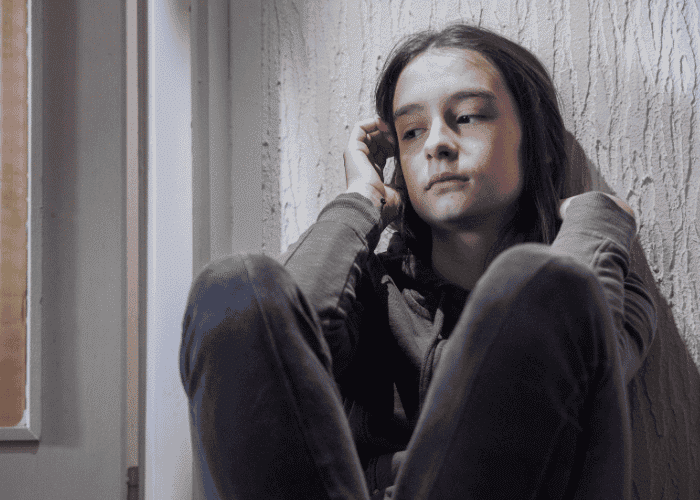Distressing Memories in Teens: Coping With Flashbacks

We often think of significant traumatic experiences as relatively rare, but research shows that by the age of 16, more than two-thirds of children report at least one traumatic event in their lives.1 While not all will go on to develop post-traumatic stress disorder, those who do may face a range of distressing symptoms that can seriously interfere with day-to-day functioning.
Among the most concerning symptoms are emotional flashbacks, which can signal deeper underlying mental health conditions. Emotional flashbacks involve re-experiencing distressing memories or sensations after a traumatic event,2 and it is important for parents to recognize the early warning signs.
If you’re concerned about distressing memories or emotional flashbacks in your teen, a mental health professional can provide support and guidance. To help parents identify emotional flashbacks in teens and get their child the support they need, this page will explain:
- What emotional flashbacks in teens look like
- The causes of trauma symptoms in adolescents
- Signs of PTSD and other trauma-related disorders in teens
- Mental health treatment options for childhood trauma
- Where to find professional support

What Are Emotional Flashbacks in Teens?
Emotional flashbacks, or reliving distressing events, can vary widely in both severity and how teens experience them.2 For example, some teens may have intense episodes where they completely lose awareness of their surroundings for several minutes or longer. Others may experience fleeting intrusive thoughts paired with a physical sense that they are reliving the traumatic event.2
It is important to understand that flashbacks are not ordinary memories. Research shows clear biological differences between experiencing a flashback and simply recalling a distressing event.2 The key distinction is that flashbacks involve a sense of reliving the event rather than just remembering it. This means the teen feels like they are back in the traumatic situation, and that it is occurring right now.2 When teens have been asked to write about their flashback experiences, their descriptions are often highly emotionally charged, involving physical sensations and feelings of fear, helplessness, and horror.3
One of the most distressing aspects of emotional flashbacks in teens is their unpredictability.2 Intrusive memories can surface suddenly, overwhelm your child without warning, and there is no reliable way to anticipate when a flashback will occur or how long it will last.2
What Are The Causes of Trauma Symptoms in Adolescents?
Traumatic events come in many forms. Psychological, physical, and sexual abuse are all common causes of trauma symptoms in adolescents, but many other experiences can also be traumatic.4 For example, community or school violence, witnessing domestic violence, natural disasters, the sudden loss of a loved one, family-related military stressors, assault, neglect, serious accidents, and illnesses can also lead to trauma symptoms.4
Adolescents are especially vulnerable to trauma symptoms due to changes that occur in the brain during puberty.4 The risk of developing post-traumatic stress symptoms is also higher in teens with a history of depressive disorder or anxiety disorder.1
Several mental health disorders are associated with childhood trauma,4 but one of the most common is post-traumatic stress disorder (PTSD). Certain factors can predispose adolescents to developing PTSD after trauma.
Gender is one prominent factor, as female adolescents are more likely to be diagnosed with PTSD than males.5 Having adequate social support during adolescence also impacts rates of PTSD after trauma. For example, studies have found that support from parents, peers, and other close relationships can help protect against the development of PTSD.5 Several studies have also found that teens with existing academic difficulties are more susceptible to PTSD and other mental health problems following traumatic events.5
Because some adolescents are at significantly higher risk for trauma-related symptoms, early identification and targeted PTSD treatment and interventions are essential to prevent additional mental health disorders following trauma.
Signs of PTSD in Teens and Other Trauma-Related Disorders
The signs of PTSD in teens and other trauma-related disorders can generally be grouped into two categories:4
- Internalizing behaviors
- Externalizing behaviors
Internalizing behaviors include freezing, social withdrawal, mood deflection, cognitive inhibition, depressive thoughts, numbing, reduced psychomotor skills, avoidance behaviors, and dissociative amnesia.
Externalizing behaviors are more extroverted symptoms like hypervigilance, impulsivity, hyperactivity, disinhibition, aggression, intrusive thoughts, paranoia, substance abuse, difficulty paying attention and concentrating, and hyperactivity.4
Children and adolescents exposed to traumatic events also report a range of somatic symptoms.6 Some physical signs to look for in your child include feeling tense or jumpy, severe nausea, and sweaty hands.6
Certain somatic symptoms occur more often in females, such as gastrointestinal distress and dizziness.6 On the other hand, adolescent males tend to show more signs of restlessness after experiencing a traumatic event.6
Somatic symptoms can also vary based on the type of trauma experienced. For example, studies show that adolescents who have experienced sexual abuse are more likely to show somatic symptoms than those who have not.6
Not all signs of PTSD are immediately apparent, which can make it difficult to identify the problem early on in your child. Some examples of signs that often initially go unnoticed are absenteeism in school and learning difficulties.7 In more severe cases, adolescents exposed to trauma may experience suicidal thoughts and attempts.7 All of these warning signs should be taken seriously, and if you notice trauma symptoms in adolescents, it is essential to seek professional mental health treatment. We cover treatment options in the next section.
Mental Health Treatment Options for Childhood Trauma
Early intervention for trauma in teens is crucial for effective treatment and preventing symptoms from worsening. There are several forms of therapy for traumatized teens, with two of the most effective being cognitive behavioral therapy (CBT) and eye movement desensitization and reprocessing (EMDR).8,9
Cognitive Behavioral Therapy (CBT)
When treating childhood trauma in teens, therapists often use a specialized form of CBT known as “trauma-focused CBT” (TF-CBT).8,10 TF-CBT combines core cognitive-behavioral principles with exposure-based techniques to treat PTSD symptoms, as well as associated depression, behavior problems, and family-related stress.10
A key component of TF-CBT is psychoeducation, which helps teens and parents understand common trauma reactions such as anxiety, flashbacks, and intrusive thoughts. Therapists also teach positive coping skills like relaxation techniques, identifying feelings, and challenging cognitive distortions.10 TF-CBT also includes modules specifically designed for abuse survivors, including physical abuse and sexual abuse10.
TF-CBT can be delivered in different environments depending on your child’s needs. For instance, your child can receive TF-CBT in outpatient treatment facilities, at home or school, or in a group setting.10
There is a manual for TF-CBT therapists to follow, which uses the acronym PRACTICE to summarize the treatment components:10
- Psychoeducation and Parenting
- Relaxation
- Affect modulation
- Cognitive coping and processing
- Trauma narrative
- In-vivo mastery of trauma reminders
- Conjoint child-caregiver sessions
- Enhancing safety and development
Strong evidence shows that TF-CBT can significantly reduce posttraumatic stress symptoms, and improvements are often maintained at one-year follow-up.10 Overall, both traditional CBT and TF-CBT are well-supported treatments for PTSD in adolescents.8,10
Eye Movement Desensitization and Reprocessing (EMDR)
Eye movement desensitization and reprocessing (EMDR) is another effective therapy for traumatized teens. EMDR combines a variety of evidence-based techniques, including imagined exposure, self-regulation, resource development, and cognitive change.9,11
What makes EMDR different from other forms of therapy is the use of alternating bilateral stimulation (SBA). This involves guided eye movements, taps, or sounds to reprocess intrusive memories in teens.9,11
The standard protocol for EMDR includes eight steps:11
- Taking the patient’s history
- Preparing the patient by teaching emotional stabilization, self-regulation, and anchoring techniques
- Choosing a target memory, understanding the negative emotional reaction to this memory, and identifying a more positive thought
- A desensitization phase, which involves alternating bilateral stimulations to reprocess the trauma
- Developing more positive beliefs to support self-esteem
- Body scan
- Closure
- Evaluating the effectiveness of the treatment and next steps
EMDR therapy for teens has gained a lot of positive attention in recent years.8 It is also being used for the treatment of complex post-traumatic stress disorder (cPTSD). This is a type of PTSD that results from long-term repeated exposure to trauma in children and adolescents.11
While more research exists supporting CBT and TF-CBT, especially for anxiety after trauma and distressing memories, EMDR is a well-supported and increasingly common treatment that should not be overlooked.

MissionPrep: Offering Behavioral Health Programs for Teenagers
If you’ve been searching for “teen mental health treatment near me”, Mission Prep is here to guide you through the next steps. Our team provides effective behavioral health programs for teenagers struggling with a range of mental health conditions, including PTSD, anxiety, depression, and other mood and thought disorders.
We offer both an intensive residential mental health treatment program and outpatient therapy, allowing you to choose the level of care best-suited for your child’s situation.
If your child is experiencing emotional flashbacks or any other trauma symptoms, call us today. We will answer any questions you have and recommend the best treatment path for your needs. Distressing memories don’t have to shape your child or family’s future.
References
- Copeland, W. E., Keeler, G., Angold, A., & Costello, E. J. (2007). Traumatic events and posttraumatic stress in childhood. Archives of General Psychiatry, 64(5), 577-584. https://doi.org/10.1001/archpsyc.64.5.577
- Brewin, C. R. (2015). Re-experiencing traumatic events in PTSD: New avenues in research on intrusive memories and flashbacks. European Journal of Psychotraumatology, 6(1), 27180. https://doi.org/10.3402/ejpt.v6.27180
- Hellawell, S. J., & Brewin, C. R. (2004). A comparison of flashbacks and ordinary autobiographical memories of trauma: Content and language. Behaviour Research and Therapy, 42, 112-121. https://doi.org/10.1016/S0005-7967(03)00088-3.
- Panuccio, A., Biondo, D., Picerni, E., Genovesi, B., & Laricchiuta, D. (2022). Trauma-related internalizing and externalizing behaviors in adolescence: a bridge between psychoanalysis and neuroscience. Adolescents, 2(4), 413-423. https://doi.org/10.3390/adolescents2040032
- Nooner, K. B., Linares, L. O., Batinjane, J., Kramer, R. A., Silva, R., & Cloitre, M. (2012). Factors related to posttraumatic stress disorder in adolescence. Trauma, Violence, & Abuse, 13(3), 153-166. https://doi.org/10.1177/1524838012447698
- Kugler, B. B., Bloom, M., Kaercher, L. B., Truax, T. V., & Storch, E. A. (2012). Somatic symptoms in traumatized children and adolescents. Child Psychiatry & Human Development, 43(5), 661-673. https://doi.org/10.1007/s10578-012-0289-y
- Cruz, D., Lichten, M., Berg, K., & George, P. (2022). Developmental trauma: Conceptual framework, associated risks and comorbidities, and evaluation and treatment. Frontiers in Psychiatry, 13, 800687. https://doi.org/10.3389/fpsyt.2022.800687
- Gillies, D., Taylor, F., Gray, C., O’Brien, L., & d’Abrew, N. (2013). Psychological therapies for the treatment of post‐traumatic stress disorder in children and adolescents. Evidence‐Based Child Health, 8(3), 1004-1116. https://doi.org/10.1002/14651858.CD006726.pub2
- Lewey, J. H., Smith, C. L., Burcham, B., Saunders, N. L., Elfallal, D., & O’Toole, S. K. (2018). Comparing the effectiveness of EMDR and TF-CBT for children and adolescents: A meta-analysis. Journal of Child & Adolescent Trauma, 11(4), 457-472. https://doi.org/10.1007/s40653-018-0212-1
- de Arellano, M. A. R., Lyman, D. R., Jobe-Shields, L., George, P., Dougherty, R. H., Daniels, A. S., Ghose, S., Huang, L., & Delphin-Rittmon, M. E. (2014). Trauma-focused cognitive-behavioral therapy for children and adolescents: Assessing the evidence. Psychiatric Services, 65(5), 591-602. https://doi.org/10.1176/appi.ps.201300255
- Rolling, J., Fath, M., Zanfonato, T., Durpoix, A., Mengin, A. C., & Schröder, C. M. (2024, October). EMDR–Teens–cPTSD: Efficacy of eye movement desensitization and reprocessing in adolescents with complex PTSD secondary to childhood abuse: A case series. Healthcare 12(19), 1993. https://doi.org/10.3390/healthcare12191993













